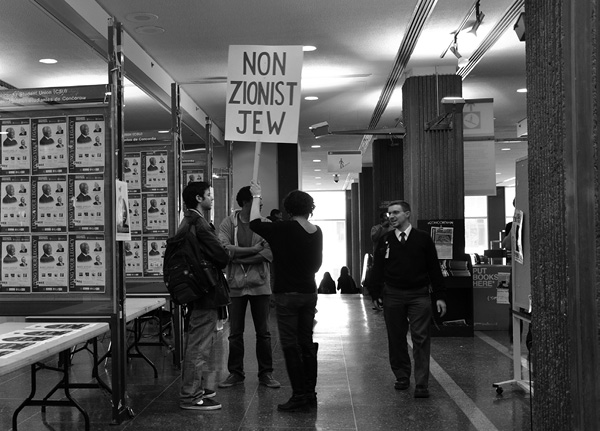
RADICAL JEWISH DISPLACEMENT
first performed on
April 1, 2011
Concordia University, Montreal, Quebec
performed once in 2011
LISA VINEBAUM
Chicago, IL
140391568i140391568n140391568f140391568o140391568@140391568l140391568i140391568s140391568a140391568v140391568i140391568n140391568e140391568b140391568a140391568u140391568m140391568.140391568c140391568o140391568m
lisavinebaum.com
RADICAL JEWISH DISPLACEMENT
LISA VINEBAUM
This performance was staged at Concordia University in Montreal in April 2011, as part of the conference “Dis/Locations: Being Out of Place.” By carrying a placard that read “Non Zionist Jew,” I sought to trouble the very notion of the “diaspora” as being outside of the state of Israel, and by extension, that the “proper place” for a Jew is within the Jewish homeland. Through this performance I also wanted to assert my place as a non Zionist Jew.
I staged this performance in response to the conference theme of dislocation, and the fact that I feel dislocated by mainstream Jewish identity formations that stress an inherent connection to the state of Israel. Concordia’s Hall Building, where the performance took place, is the site of ongoing clashes between Palestinian and Jewish students, and censorship by university authorities. Like many of my other performances, this one used a placard as a means of generating discussion with viewers. By staging this performance in a site where confrontation had superseded productive dialogue on the subject of the Israeli-Palestinian crisis, I sought to initiate discussion on the matter. Several students stopped me to ask questions, and conversations ensued. The image here shows me having a heated discussion with a Jewish student arguing in favor of the separation barrier being built in the West Bank. Despite our striking ideological differences on the matter, we were at least having a dialogue.
Ironically, after only about 10 minutes, a security guard (seen here) approached me and told me that I had to stop the performance, despite the fact that I was faculty at the university at the time, and that my performance was affiliated with a university event. The act of documenting this performance for archival purposes was transformed into an act of documenting its censorship and subsequent termination by campus security. It was also a furtive and transgressive act, as my photographer was forced to lie about the fact that this intervention by campus security had been documented. The urgency of the performance-to take a political stance, to foster discussion and dialogue-was displaced by the “emergency” of forced intervention. The documentary act of recording the performance for posterity was transformed into the act of recording the moment of its suspension.